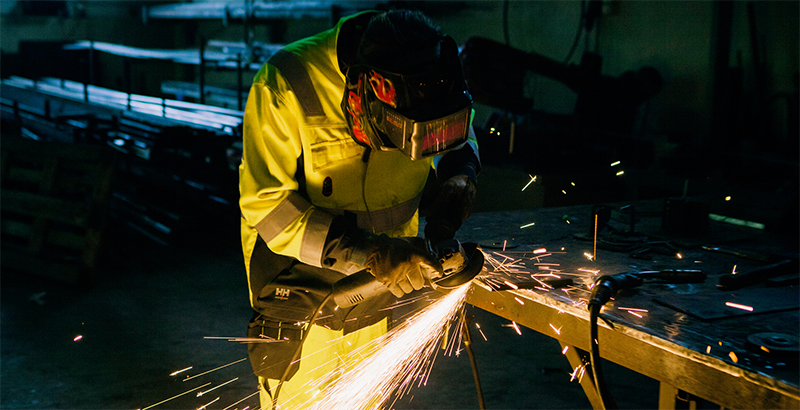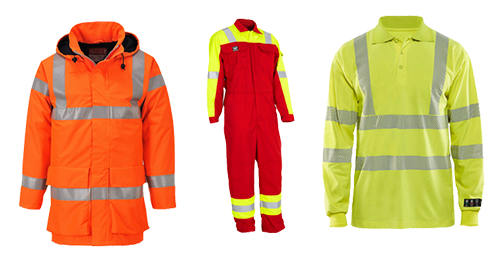
What is FR Clothing?
Flame retardant or FR clothing is designed to ensure protection from open sources of ignition, or from tools and machinery which give off excess heat. Unlike regular work clothing which will normally burn through or catch alight, FR clothing will delay and suppress the spread of flames as well as giving the wearer thermal insulation from heat. These products are specially designed to withstand melting, hence reducing the risk of injury from burns. To increase their effectiveness, FR clothing works best when layered together with baselayer products to offer the highest levels of protection.
Treated vs Inherent Fabric
Products designed to protect against the risk of heat and flames can do so via different processes – FR treated and inherent FR. Ultimately they will both provide excellent protection against convective heat and spread of flame, but both have their unique nuances to consider.
Treated Fabrics
FR treated fabric refers to products which have undergone a special manufacturing process whereby a combination of chemicals are added to a yarn, fibre or finished fabric composition in order to create a new FR fabric work item. Unlike their inherent counterparts, a chemically treated flame retardant product will begin to lose its FR properties over time, either during the laundering process, or due to exposure to chemicals and other abrasives. With a treated garment it is always essential to follow the manufacturers care instructions, as this will ensure the longevity of the FR properties.
Inherent Fabrics
Inherent FR is a term which is lent to fabrics which have had FR properties permanently intertwined into the fibres of the garment itself. Good examples of an inherent fabric are aramid fabrics such as Nomex – which has FR properties present at a molecular level. Modacrylics also benefit from an inherent finish, which is added during the textile process. The advantage of buying an inherent FR product is that due to the introduction of the FR qualities at the fibre level, their protective effectiveness will never diminish over time.

How do I care for my FR Clothing?
To ensure the effectiveness of your FR clothing, you should always follow the manufacturers care instructions. Failure to do so will have a detrimental effect on the level of protection they offer, which could result in injury. Never use bleaches or any detergents which include bleach, and when dry cleaning always avoid any solvent – with the exception of Trichloroethylene (TCE). When tumble drying, its also best to do so on a low heat. Many FR garments also share other safety properties, such as retro-reflective stripes and fluorescent finishes, and should be washed separately to help reduce abrasion against other garments. It is also well advised to turn these products inside out when washing them to help further protect them during the laundering process.
Who would wear FR Clothing?
FR clothing can cater for a number of industries and job roles that require the wearer to work in hazardous environments where they will come into exposure from heat and flame, a great example of this is the petrochemical, oil and gas industries where there is a constant exposure and risk of heat and flame exposure throughout the working day. Welders and fabricators will also come into contact with heat and flame, as well as sources of ignition and sparks, all of which can pose a significant risk to personal safety, should protection not be used correctly.
FR standards explained
There are 3 main standards which are applicable for heat and flame exposure, all of which provide slightly different properties covering what hazards they are protecting the wearer against.
EN ISO 11612:2015
This is the latest revision of the EN ISO 11612 standard which has superseded EN531, and is given to clothing which is designed to offer body protection (with the exception of the hands) from the hazard of heat and flame. Most FR Overalls, shirts and trousers will fall into this category. There are no specific items which adhere to this standard for the head, hands and feet, however you will find there are EN ISO 11612:2015 products such as gaiters, hoods and overboots which will offer protection. FR clothing falling into this standard is designed to limit the spread of flame in the event of exposure to convective or contact heat, and will also protect against molten splashes.
EN ISO 14116:2015
This standard specifies the performance requirements for products which offer limited flame spread properties of all materials, material assemblies and protective clothing. This is designated to products which may expose the user to smaller risks of exposure against fire such as small igniting flames. EN ISO 14116:2015 products are best suited to environments where there is no real significant heat hazards involved. When protection against heat hazards is a necessity, then EN ISO 11612:2015 garments are recommended to ensure your safety.
EN ISO 11611:2015
This is the standard which is lent to FR clothing such as hoods, aprons, gaiters and gauntlets which are worn during the welding and allied processes. Garments and accessories which fall into the EN ISO 11611:2015 are designed to protect the wearer not only against short contact times with flame and radiant heat, but to offer protection against the hazard of spatter and small splashes of molten metals, and will also help to minimize the risk of exposure to accidental contact with live electrical conductors, providing protection up to 100 V d.c(approximately) in normal welding environments.
Additionally, flame retardant clothing may also adhere to a number of additional safety specifications such as EN ISO 20471 for high visibility, EN 343 Foul weather protection, or EN 1149-5 Antistatic protection. Clothing which covers a wide variety of safety specifications is often referred to as Multinorm.
Click our logo below to view our full range of flame retardant clothing.
